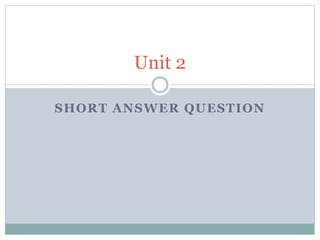
Unit 2 short answer questions
- 2. Identify and describe the three party eras. How is the current period of government different than these eras? Democrats vs. Whigs Andrew Jackson appeals to the masses rather than the elite Republicans vs. Democrats ½ Republican Party began with the anti-slavery movement 2/2 Period of Capitalism and Big Business Democrats vs. Republicans FDR introduces the New Deal (government spending on social programs) JFK and LBJ continue spending on social programs
- 3. Identify and describe the three party eras. How is the current period of government different than these eras? Current Period of government differs due the following: No one party has been dominant through this era Party Dealignment- voters are no longer clearly associated with a political party Ticket splitting- voting for candidates from different political parties on the same ballot Divided Government- president and the majority of congress are from different political parties
- 4. Identify and describe the two ways states nominate candidates to go to the national convention. How has this process changed? Primary- voters directly nominate candidates Caucus- state party leaders work with voters to select candidates -Initially most states used a caucus as state party leaders nominated candidates in secret -Riot @ the 1968 Democratic National Convention by women and minority groups that felt under represented by the process -Led to the McGovern Frasier Commission which forbid party leaders from secretly selecting candidates. Most states switched to conduct primary elections
- 5. Identify and describe two pieces of legislation that have attempted to regulate campaign financing. (list specific provisions) Discuss their effectiveness. 1974 Federal Election Campaign Act Limited Individual Donations to $1000 Required candidates to disclose all donations and expenses Created the FEC to enforce Campaign Laws Groups must register as PACs to donate to candidates -LOOPHOLE- Soft money- money donated for generic party use McCain Feingold Bill Attempted to limit soft money donations
- 6. Describe how the Electoral College works and list three criticisms of this system. Electoral College Each state is given a number of electors equal to its number of it’s representatives in the House and Senate The candidate that wins the popular vote in each state receives all of that states electoral votes The candidate that wins the majority (270) of the electoral votes wins the election Criticisms A candidate could win the popular vote but lose the election System makes it difficult for third parties to gain significances Swing states get most of the attention
- 7. What happens over the course of an election year (Election Time Table) See Timeline Diagram
- 8. Identify two major differences between a political party and an interest group Interest Groups Policy Specialist Focus on a narrow range of issue Influence Politics through: Lobbying- using expert analysis to persuade and inform politicians Electioneering- helping like minded candidates get elected by providing financial aid and campaign help Litigation- challenge existing laws through the court system Political Parties Policy Generalist Focus on a wide range of issues Influence Politics through attempting to win an election